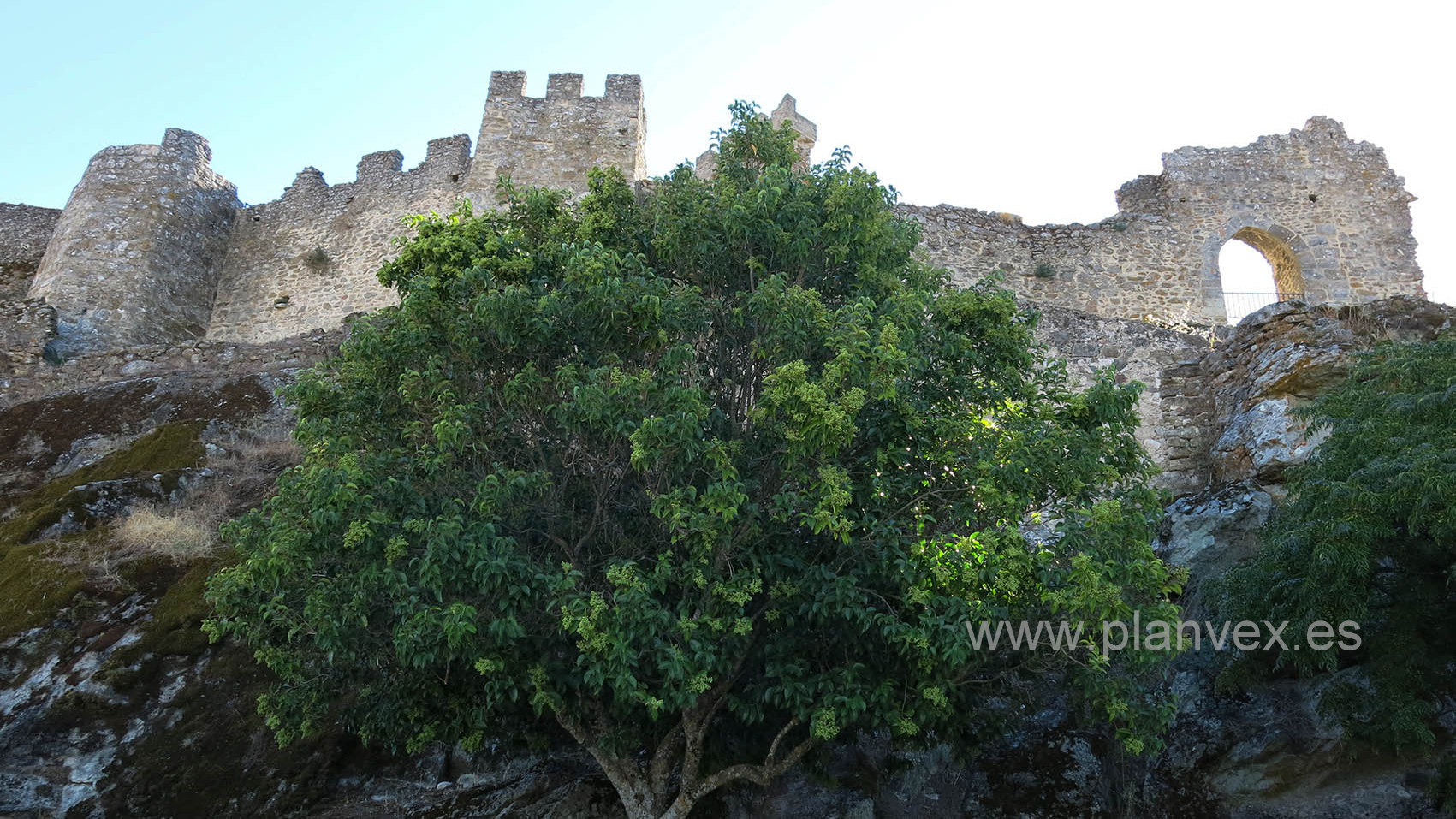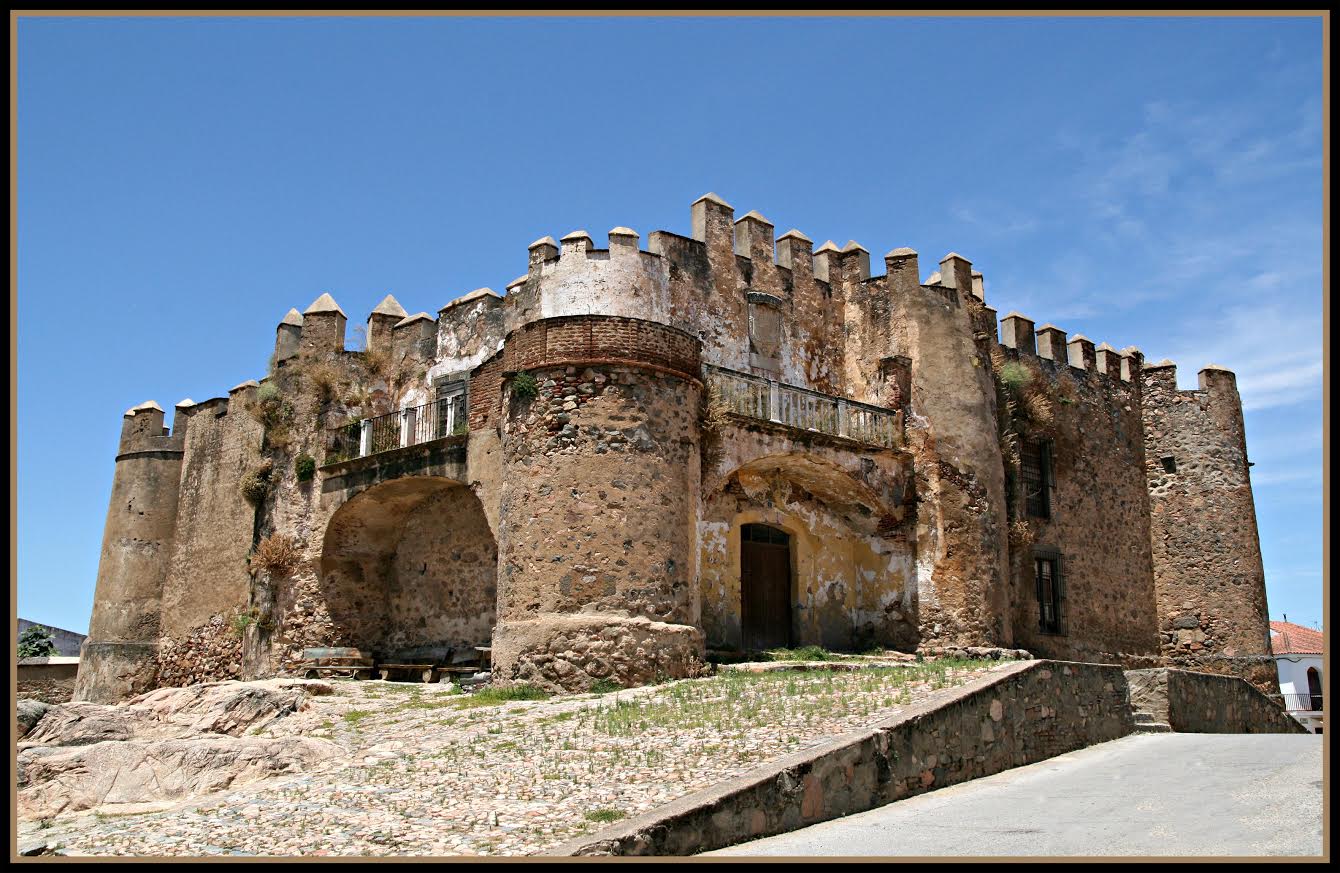
Discover the castles of Extremadura, whether they are on extensive meadows full of oak trees or in urban settings. They are a must stop to view history and imagine all kinds of story -book scenes.
A National Artistic Treasure in “Calera de León”
Legend has it that while Captain Pelay Pérez Correa was battling with the Arabs in the Thirteenth century and the night was approaching, he shouted: “Santa Maria, stop your day” Apparently his plea was answered giving him time to defeat the enemy. In gratitude for the miracle he raised this castle in the middle of the battlefield.

At Calera de Leon, many neighbors say that it was originally built as a fortress, although over time it became the Monastery of Tentudia, one of the best examples of Spanish Mudejar architecture, as declared by Pope Leo X. Inside the Monastery you can contemplate the altarpiece made by Maestro Niculoso Pisano; the image of the Virgin of Tentudia dating from the 18th Century; and the cloister from the beginning of the 16th Century.
Visiting Hours- Open to the public: From May to October, from 11:00 AM to 6:00 PM. From November to April, from 10:00 AM to 5:00 PM. Closed on Monday.
A Castle with a bullring in Fregenal
The Castle of “Fregenal de la Sierra” (Fregenal of the Mountain Range) can be considered a castle of the plains. Historically, King Alphonse X mentioned it in 1283 when built and granted to the Templar. The political stability of the 16th Century left the Castle abandoned, until the War of Independence, when forced works of remodeling were implemented in its crenellated walls.

Along the years, its military function was completely lost and since the end of the XVIII Century it houses a bullfighting ring and also, serves as an open- air market.
Visiting Hours- Open to the public: From September to June, from 10:00 AM to 2:45 PM and from 5:00 PM to 7:00 PM. From July and August, from 10:00 AM to 2:45 PM and from 6:00 to 8:00 PM.
The Castle of Luna in Albuquerque
Don Alvaro de Luna, Master of the Order of Saint James (Orden de Santiago) was one of its main constructors. Also, the Castle is named after this historic person. Its origin dates back to the XV Century and architecturally it is built around its magnificent tower, called the Tower of Homage (Torre del homenaje) which is five levels high and has an impressive pointed arch that provides access to the upper floors. In 1933 the Castle was named a National Monument and after the Spanish Civil War it was restored.

Visiting Hours- Open to the public: From spring to summer, from 11:00 AM to 1:00 PM and 5:00 PM to 6:00 PM. From autumn to winter, from 11:00 AM to 1:00 PM and 4:00 PM to 5:00 PM. Closed on Monday.
Unexpected Castle of “Valencia del Ventoso”
The Castle of Valencia del Ventoso is a fortress located inside the town. Historians claim that this location indicates that in addition to the defensive purposes the Castle was used for civil functions.
At present its principal commitment is to provide the grounds for the celebration of the Medieval Fair of this municipality, every August. However, its origin is neither defensive nor military. The Commander Rodrigo Cárdenas, a Saint James Knight, started the construction of what was to be his house in 1477.

A well populated fortress in Medellin
That was the description of Medellin by the Arabs at the beginning of the 10th Century, although the place reaches its greatest splendor in the 15th Century. The Castle of Medellin witnessed many historical events, such as the feud between Doña Beatriz Pacheco, who supported “The Beltraneja”, the unrecognized daughter of King Enrique IV of Castile, with the troops of the Queen of Castile. In this conflict Pacheco, heir of the Medellin County, required military aid from Portugal. The Castle’s foundation also supported vandalism and attacks form the French, after the battle of Medellin. The significance of these historic events makes the Castle of Medellin, the most representative monument of this region called “Las Vegas Altas”.

Open to the public: Guided tours, at: 11:30 AM, 12:30 PM, 6:30 PM, 19:30 PM and 20:30; every day.
Post Cards from the dehesa (meadows) of Montánchez
The religious Order of the Knights of Saint James, in the Province of Cáceres, was responsible for furnishing and manning the Castle of Montánchez. It was used as a residence for Commanders and other authorities. The outer walls of the Castle have survived during the centuries, and now archeological excavations are being conducted from the cellar of the Castle. The Castle is depicted in the main photograph of this report and it is an ideal spot to enjoy sunsets over the extensive Extremadura grazing meadows.
A place with defensive characteristic
Raised over an old Arab fortress, the Castle of Trujillo was constructed between the 9th and 12th Centuries. It was built over the highest elevation of this region in the province of Cáceres. It still conserves two cisterns of the old Arabic palace. The rest is constructed with blocks of granite of ashlar masonry. Seventeen square towers, of defensive character, surround the Castle. Four of the original seven gates are preserved: Saint Andrew, Saint James, Coria and the gate of the Triumph. As a historical curiosity, Juana the “Beltraneja” took refuge in this castle during her dispute with Queen Isabel I of Castile.
Visiting Hours- Open to the public: From October to May, from 10:00 AM to 2:00 PM and 4:00 PM to 7:00 PM. From April to September, from 10:00 AM to 2:00 PM and 5:00 PM to 8:00 PM. The Castle is open every day, from Sunday to Sunday.
View the valley of river Alagón from Coria
The Castle of Coria is a striking structure that is in the middle of the historic center of the city. It has a Tower of Tribute of a pentagonal plant with a defensive and stately character. It also has a small semicircular tower, which was built in 1472 by the architect Juan Carrera. From its towers you can see the whole city of Coria and much of the Alagón valley.

Granadilla, fortress of the evicted village
Like the houses of Granadilla, Extremadura’s museum village, the Fortress survived the forced abandonment. This is a predominant building, which imposes its presence as soon as you arrive to the town. The Duke of Alba, Garcia Alvarez de Toledo and Carrillo, ordered the construction of the Fortress in 1473 and 1478. It consists of a central prismatic body and four semi-cylindrical bodies attached to each of the sides of the central construction.
The Castle of Granadilla is one of the cinema sets chosen by Spanish filmmaker Pedro Almodóvar, for Átame (Tie me up! Tie me down!) The 1990 film is an important production for this famous director.
Visiting Hours- Open to the public: The visiting hours for the Fortress is the same as the visiting schedule for the village of Granadilla. The gate opens from 9:00 AM to 1:00 PM and from 5:00 PM to 7:00 PM.
Historical remains at Mirabel
The magnificent building of the Castle of Mirabel still shows signs of what it was during the Fifteenth Century. Originally, it was one of the fortresses that King Alphonse VIII possessed after the founding of Plasencia. The Almohad armies destroyed the original building in 1196. Centuries later it was rebuilt, as it became part of the wealth of the Marquis of Mirabel. Vestiges of this remodeling can be freely visited today.
A similar situation happens with the Castle of Portezuelo in the Province Cáceres. Today’s remains are an archetype of the medieval fortress. The origin dates back to the XII Century and has changed hands between Christian and Muslim lords. It is also known as the Castle of Marmionda, because of a legend of a beautiful Moorish princess associated with the site.
planVE, la guía de ocio de Extremadura
Original article by Noelia Pérez
Translated by Susana Windt
Un paseo entre castillos de Extremadura
Um passeio entre os castelos da Estremadura
Published on July 2017










